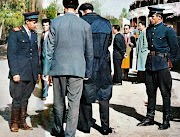Tirana Liberated: The Capital That Redefined Albania's Future
Diary of Albanian Chronicles
November 17, 1944
On November 17, 1944, the bells of Tirana rang out in celebration, marking the end of a long and dark chapter in Albanian history. The liberation from Nazi-Fascist domination signaled the beginning of a new era, full of hope and promise. Yet behind the celebrations and popular enthusiasm lay a complex and multifaceted reality, woven with joys and sorrows, victories and challenges. The withdrawal of Nazi forces from the capital embodied the realization of years of struggle, sacrifice, and resistance by the Albanian people, opening the door to a renewed political and social path. The entire nation felt that with the liberation of Tirana, a fundamental chapter for its future was being written.
Pandi Mele, The Voice of Radio Tirana, 1976, olio su tela / oil on canvas, 103 × 112 cm
The Context of Occupation and the Hardships of the Population
To grasp the significance of this event, it is necessary to look back and consider the difficulties and tensions Albania had endured since 1943. After the fall of the Fascist regime in Italy and the subsequent withdrawal of Italian troops, Albania came under direct German control. Tirana, the country's capital and a vital administrative and cultural center, quickly became a symbol of German military repression. The Nazi occupation imposed an intensive regime of surveillance and control over the city, while the population lived under constant pressure, restricted in their personal freedoms and forced to endure severe material deprivation. Amid this oppressive climate, the National Liberation Movement, led by Enver Hoxha, consolidated its forces with the goal of ending an occupation perceived as an existential threat to Albanian identity and sovereignty.
The Beginning of the Battle for the Liberation of Tirana
The final offensive to liberate Tirana began in October 1944. The German army, which regarded Tirana as a strategic point, had fortified the city with a series of defensive structures. Streets, squares, and public buildings had been transformed into control posts, while the main access points were constantly patrolled. The partisan resistance, though less militarily equipped than the Nazi troops, leveraged its knowledge of the terrain and the support of the local population. This advantage allowed the fighters to move swiftly and attack with precision, making each raid an opportunity to weaken enemy defenses. Despite limited resources and means, the partisan brigades adopted sophisticated guerrilla strategies, including ambushes and surprise attacks, aimed at progressively undermining German resistance.
A Determining Collaboration and the Unity of the Population
The partisans' victory was not only a military achievement but also the result of close cooperation among brigades from various regions of Albania. This united effort demonstrated how the resistance against Nazi occupation transcended geographical and cultural barriers, involving men and women from diverse social backgrounds and differing political beliefs. In Tirana, the fight for liberation was not carried out solely by seasoned fighters but also saw the active participation of a significant portion of the civilian population. Notably, many Albanian women joined the movement, taking on pivotal roles in operations. This contribution marked an important milestone in the history of the resistance and left a lasting legacy for the future of women’s participation in public life. Thus, the liberation of Tirana was not only a military triumph but also an achievement for a people who, through shared sacrifices and hardships, found the strength to rise again and build a common future.
Significance and Prospects for the New Albania
The liberation of the Albanian capital took on an emblematic value, transforming Tirana into a symbol of hope and renewal for the entire nation. The withdrawal of Nazi forces from the city marked the beginning of a political and social transformation process that would profoundly influence Albania's future. Thanks to the support of its citizens and the success of the partisan organization, the National Liberation Movement established itself as the country's new leading force, laying the foundation for an autonomous and independent government structure. The liberation of Tirana had not only symbolic but also practical significance, facilitating the end of German occupation in other parts of Albania. By the end of November, the entire national territory had been freed from Nazi presence.
This event marked the beginning of a new and complex phase for Albania: a path of self-determination where the Albanian people were finally free to build their own political and cultural identity based on national values. The capital, long a crossroads of cultures and ideas, now represented a driving center for the renewal of a people looking toward the future with new aspirations. Tirana, reclaimed by the Albanians, stood as the focal point of a nation determined to forge a new sovereign and independent identity, outlining a course that would define the country's destiny for decades to come.
Sources and Bibliography
1. Wikipedia - Liberation of Tirana: contesto dell’evento e descrizione delle operazioni militari coinvolte.
2. Osservatorio Balcani e Caucaso Transeuropa - 29 novembre: l’Albania è Libera, ma comincia la dittatura di Enver Hoxha: esamina le conseguenze politiche della liberazione della capitale.
3. RTSH RTI - 29 novembre 1944, Albania libera e indipendente: dettagli sulle celebrazioni e la memoria storica legata all’evento.










0 Comments